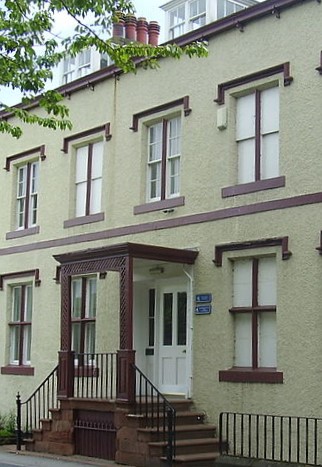Hood mould

|
| Formerly Barony House, the music block at St Bees School in the West Cumbrian village of St Bees, England, is known as the Fox Music Centre. It is a rendered Victorian building with rectangular hood mouldings and label stops. |
Contents |
[edit] Introduction
The Penguin Dictionary of Architecture (third edition) was published in 1980. It was created for Penguin Reference and compiled by John Fleming, Hugh Honour and Nikolaus Pevsner.
It defines a hood mould as: ‘A projecting moulding to throw off the rain, on the face of a wall, above an arch, doorway or window; can be called dripstone or, if rectangular, a label.’
It may also be referred to as a drip mould (positioned over something other than an archway), a label or a label mould.
[edit] Purpose
From the side, a hood mould may have an upper surface that angles downward and includes a recessed space that serves to direct drips away from the opening.
At its lower ends, the hood mould may terminate on a column capital. It may also be finished with another moulding structure referred to as a label stop. A label stop can be a boss that is plain or decorative.
[edit] History
The hood mould initially appeared during the Romanesque period. It was used to protect carved mouldings from erosion and other damage caused by rain.
Eventually, the hood mould became a highly decorative feature, particularly important during the Gothic period. Hood moulds appear above many external arches found in Gothic structures built in much of Europe. In England, they were also used over interior arches - commonly those above nave arcades.
With the introduction of rectangular windows for residential buildings, hood moulds were adapted for domestic architecture.
[edit] Related articles on Designing Buildings
Featured articles and news
One of the most impressive Victorian architects. Book review.
RTPI leader to become new CIOB Chief Executive Officer
Dr Victoria Hills MRTPI, FICE to take over after Caroline Gumble’s departure.
Social and affordable housing, a long term plan for delivery
The “Delivering a Decade of Renewal for Social and Affordable Housing” strategy sets out future path.
A change to adoptive architecture
Effects of global weather warming on architectural detailing, material choice and human interaction.
The proposed publicly owned and backed subsidiary of Homes England, to facilitate new homes.
How big is the problem and what can we do to mitigate the effects?
Overheating guidance and tools for building designers
A number of cool guides to help with the heat.
The UK's Modern Industrial Strategy: A 10 year plan
Previous consultation criticism, current key elements and general support with some persisting reservations.
Building Safety Regulator reforms
New roles, new staff and a new fast track service pave the way for a single construction regulator.
Architectural Technologist CPDs and Communications
CIAT CPD… and how you can do it!
Cooling centres and cool spaces
Managing extreme heat in cities by directing the public to places for heat stress relief and water sources.
Winter gardens: A brief history and warm variations
Extending the season with glass in different forms and terms.
Restoring Great Yarmouth's Winter Gardens
Transforming one of the least sustainable constructions imaginable.
Construction Skills Mission Board launch sector drive
Newly formed government and industry collaboration set strategy for recruiting an additional 100,000 construction workers a year.
New Architects Code comes into effect in September 2025
ARB Architects Code of Conduct and Practice available with ongoing consultation regarding guidance.
Welsh Skills Body (Medr) launches ambitious plan
The new skills body brings together funding and regulation of tertiary education and research for the devolved nation.
Paul Gandy FCIOB announced as next CIOB President
Former Tilbury Douglas CEO takes helm.






















